Wonderful Winter Squash – Plus bonus Recipe

Cooler weather is here and while pumpkin certainly gets the most attention, it is just one of the many winter squash varieties belonging to the Cucurbitaceous, or gourd family. Winter squashes come in many shapes, sizes, and colors and they make lovely fall decorations, but they are also nutritious and delicious. Though technically fruits, they are nutritionally more like vegetables and are most often used in recipes like they are vegetables.
Research has shown that a diet rich in fruits and vegetables may help to reduce the risk of cancer and heart disease; improve blood sugar control in diabetes; protect eye health; boost your mood; and increase the effectiveness of your immune system. Winter squash is high in vitamins and minerals like vitamin C, magnesium, potassium, fiber and carotenoids, which act as antioxidants. It is a nutrient-rich, high fiber and low-calorie food that is relatively low in carbohydrates and can be incorporated into your diet in a variety of ways to try to boost your fruit and vegetable intake.
Types of squashes:
- Butternut

- Delicata

- Spaghetti

- Hubbard

- Acorn

- Sugar (pie) pumpkins

When choosing a winter squash, look for one that is firm without soft spots or cracks. The exterior should not be shiny and when you give the squash a tap, it should sound hollow if it is ripe. Store in a cool, dark area of your kitchen, but do not refrigerate.
Winter squash does have a thick surface which can make preparation a challenge. While pre-cut butternut squash is available at most grocers, the other squash varieties are usually sold whole. To make it easier to cut into a whole squash, after rinsing it off and drying it, you can pierce the skin in several places with a knife or a fork, then microwave it for 3 or 4 minutes (longer if it’s a bigger squash) to soften the skin a bit so that you can slice into it and cook it however you choose.
Some easy ways to boost your winter squash intake:
- Replace pasta: spaghetti squash that has been roasted can be scraped out and the stands can be used like noodles with your favorite sauce. Try a vegetable spiralizer to cut butternut squash and use in place of some, or all, of your noodles.
- Sub out for other side dishes-roast acorn squash with maple syrup or with parmesan cheese and herbs for a tasty side.
- Swap for potatoes: roast and mash butternut squash and serve like you would mashed potatoes.
- Make a one-dish main course: stuff spaghetti or acorn squash halves with lean ground meat, brown rice, black beans, and tomatoes for a hearty meal.
- Chili and soup: sugar pumpkin can be a delicious ingredient in vegetarian chili. Butternut squash soup can be made from roasted butternut squash blended with onions and spices, combined with vegetable broth, and pureed.
Try this simple recipe
Butternut Squash Soup
Adapted from yummyhealthyeasy.com
Ingredients:
- ½ Tbsp. olive oil
- 2 garlic cloves minced
- 1 onion diced
- 1 butternut squash peeled and diced into cubes
- 32 ounces vegetable broth
- 1-2 tsp. salt
Directions:
- In a dutch oven pot (or heavy pot), heat olive oil over medium heat. Add onion and garlic. cook until softened, about 5 minutes.
- Add cut up butternut squash and vegetable broth. Bring to a boil then cover and simmer for 15-20 minutes until squash is softened.
- Carefully pour entire contents of pot into blender (I use my Vitamix). Add salt.
- Carefully blend until smooth. Serve in bowls with thyme if desired. Enjoy!